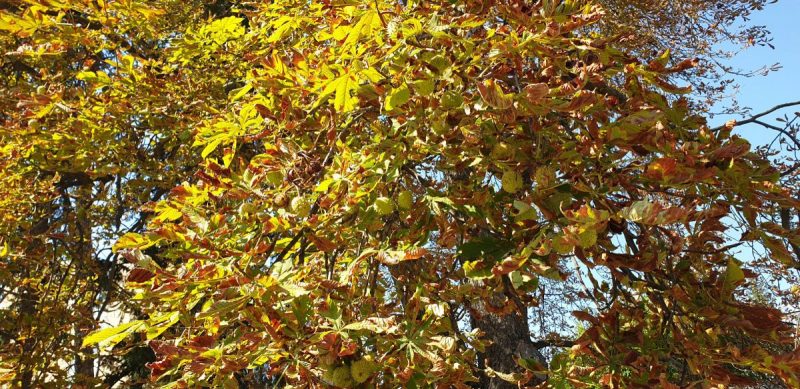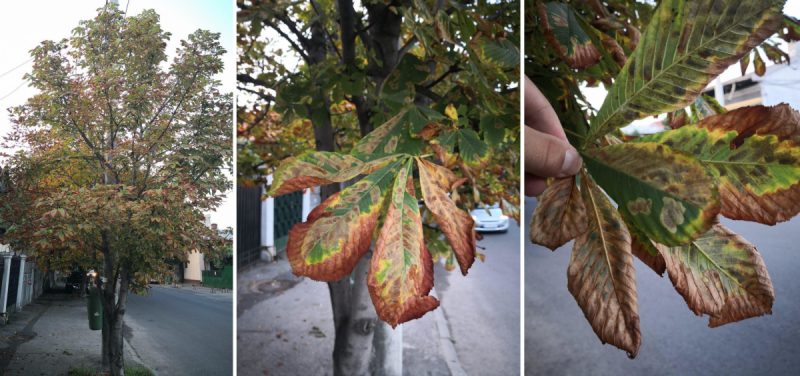The horse-chestnut leaf miner (Cameraria ohridella) – pest management

The horse-chestnut leaf miner, Cameraria ohridella, is a leaf-mining moth first discovered in Macedonia in 1984 and introduced as a new harmful species in 1986.
Description and biology. Cameraria ohridella has 4 stages of development: egg, larva, pupa, and adult. The eggs are white and have a size of 0.2-0.4 mm. The larvae go through 4 stages of development during feeding and another two stages until they become pupae. They have different lengths depending on the stage they are in (0.5-3.5 mm). The pupae are brown, 2.9-4.5 mm long, and the female specimens are difficult to distinguish from the male ones. The adults are 4-5 mm long and are brown moths, with transverse white stripes, bordered by a black line.
The biological cycle
Cameraria ohridella can produce between one and four generations a year. Female specimens can lay up to 80 eggs. The eggs are laid separately on the upper surface of the leaf. The young larvae feed on the leaf tissue and form reddish-yellow spots in the mined places. The number of moltings is usually four. The last stage of the larva forms a round and flat cocoon, where the pupation takes place. It overwinters in the pupal stage, the pupa being resistant to low temperatures.
Signs of attack and detection of infestation. It causes significant damages, the attack being manifested through the browning of the chestnut leaves in late summer. Following the attack, the capacity for photosynthesis decreases. Despite the worrying appearance of the trees, they survive repeated attacks, managing to leaf normally in the following year. The larva feeds on the leaf tissue, causing brown spots to appear. The attack spreads rapidly, encompassing the entire crown of the tree, and the leaves dry out (sometimes even fall), the phenomenon resembling the entry into the vegetative dormancy period, which occurs in autumn. The new growths are also affected, the process is repeated several times per season.
Control. To control this pest, treatments with specific insecticides for the horse-chestnut leaf miner can be applied.
Recommended products
-
You can find products on a different store
Change Store -
You can find products on a different store
Change Store -
You can find products on a different store
Change Store -
You can find products on a different store
Change Store -
You can find products on a different store
Change Store -
You can find products on a different store
Change Store -
You can find products on a different store
Change Store -
You can find products on a different store
Change Store -
You can find products on a different store
Change Store -
You can find products on a different store
Change Store -
You can find products on a different store
Change Store -
You can find products on a different store
Change Store -
You can find products on a different store
Change Store -
You can find products on a different store
Change Store -
You can find products on a different store
Change Store -
You can find products on a different store
Change Store -
You can find products on a different store
Change Store -
You can find products on a different store
Change Store -
You can find products on a different store
Change Store -
You can find products on a different store
Change Store -
You can find products on a different store
Change Store -
You can find products on a different store
Change Store -
You can find products on a different store
Change Store -
You can find products on a different store
Change Store
Control is difficult due to the size of the trees and treatments must be performed by specialized personnel. It is also recommended to use an adjuvant together with the prepared insecticidal solution.
Recommended products
-
You can find products on a different store
Change Store -
You can find products on a different store
Change Store -
You can find products on a different store
Change Store -
You can find products on a different store
Change Store -
You can find products on a different store
Change Store -
You can find products on a different store
Change Store -
You can find products on a different store
Change Store -
You can find products on a different store
Change Store -
You can find products on a different store
Change Store -
You can find products on a different store
Change Store -
You can find products on a different store
Change Store -
You can find products on a different store
Change Store -
You can find products on a different store
Change Store -
You can find products on a different store
Change Store -
You can find products on a different store
Change Store -
You can find products on a different store
Change Store -
You can find products on a different store
Change Store -
You can find products on a different store
Change Store -
You can find products on a different store
Change Store -
You can find products on a different store
Change Store -
You can find products on a different store
Change Store -
You can find products on a different store
Change Store -
You can find products on a different store
Change Store -
You can find products on a different store
Change Store

















































































































































































































































































































































































































































